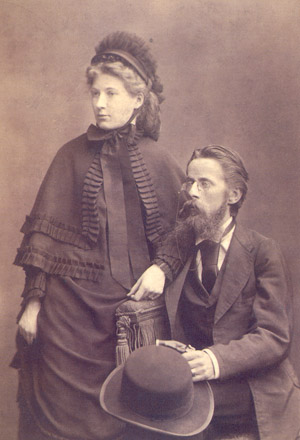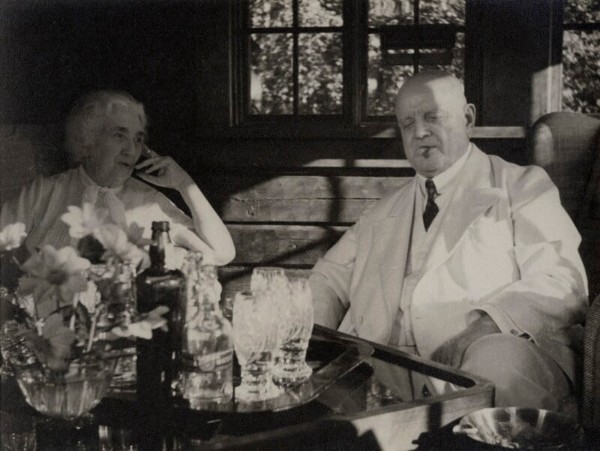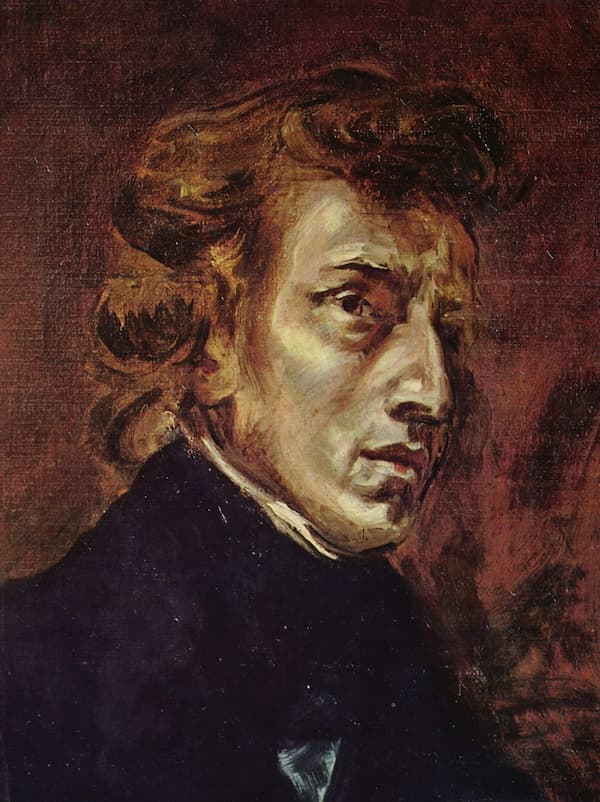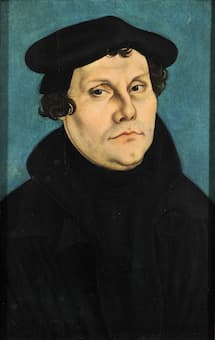
Martin Luther
The term “chorale” can be somewhat confusing. That’s not surprising, as the meaning is slightly different in German and in English usage. Let’s not get into the technical differences but simply say that a “chorale” is the congregational hymn of the German Protestant church service. Since the church reformer Martin Luther (1483-1546) wanted hymns to be sung in German during church services, he translated many religious texts from Latin so that people could understand the words. These new texts needed simple and catchy melodies so that everyday churchgoers could easily sing along. Luther adjusted, arranged, composed, and published many of such chorale melodies. Since Johann Sebastian Bach was the city organist in Leipzig he was very familiar with the Lutheran hymns, and conventionally, he would support the singing of the congregation by playing a harmonic accompaniment. In addition, for his church cantatas, the closing chorale was typically sung in four-voice harmony with the chorale melody sounded by the soprano voices. However, in the hands of Bach, these chorale melodies became the raw materials for a huge and magnificent variety of compositions settings. Whether in the original settings or transcribed/arranged, a good number of Bach chorale settings have achieved the status of pop favorites. So we decided to feature some the most popular chorale settings by Johann Sebastian Bach, starting with “Jesu, Joy of Man’s Desiring.”
Johann Sebastian Bach: Cantata BWV 147 “Jesu, Joy of Man’s Desiring”

Jesu, Joy of Man’s Desiring
Originally, Bach had written his Cantata BWV 147 “Herz und Mund und Tat und Leben” (Heart and mouth and deed and life) for the celebration of Advent in Weimar in 1716. Specifically, it celebrates the “Visitation,” the visit of Mary, who was pregnant with Jesus to her cousin Elizabeth, who was pregnant with John the Baptist. According to the scriptures, the unborn John became aware of the presence of Christ, “and he leapt for joy as he was cleansed from original sin and filled with divine grace.” Once Bach had made his way to Leipzig, he took up this work for the Marian feast of Visitation on 2 July 1723.
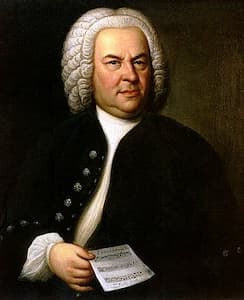
Johann Sebastian Bach
An anonymous author adapted the original cantata text and Bach expanded the work from six movements to ten. And that included a chorale setting with the title “Jesu, Joy of Man’s Desiring.” This movement has been widely popular and is often performed at wedding ceremonies, and also during celebrations of Christmas and Easter. It has also spawned numerous arrangements and transcriptions, and Dame Myra Hess prepared one of the best known in 1926 for piano solo. Bach certainly knew a good tune when he heard one.
Johann Sebastian Bach: Cantata BWV 140 “Sleepers Awake”
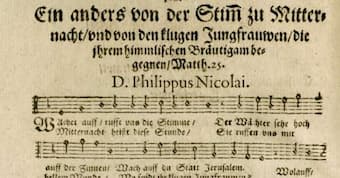
Hymn tune by Philipp Nicolai
It may well be that Cantata BWV 140 “Wachet auf” (Wake, Awake for Night is Passing) is Bach’s most famous cantata and one of his best-loved works. This cantata was written for the 27th Sunday after Trinity, which is the last Sunday in the Church Year, on 25 November 1731. Scored in seven movements, this work has been described “as one of the composer’s most beautiful, most mature and, at the same time, most popular sacred cantatas.” And a Bach scholar added, “it is a cantata without weaknesses, without a dull bar, technically, emotionally and spiritually of the highest order, its sheer perfection and its boundless imagination rouse one’s wonder time and time again.” The fourth movement, “Zion hört die Wächter singen” (Zion hears the watchmen singing) is scored as a chorale prelude with the tenors singing the chorale against the famous lyrical melody.

Bach: Cantata BWV 10/648 “My soul magnifies the Lord”
The chorale was actually written by the Lutheran pastor Philipp Nicolai during a terrible plague epidemic in the town Unna, near the German city of Dortmund. In the depth of this fearsome epidemic that ravaged his town, he wrote a collection of meditations to “comfort other sufferers whom God should also visit with the pestilence.” He called this collection a “Mirror of Joy,” and described it as a “hopeful light shining in the midst of terrible darkness.” Over 400 years later, and during yet another pandemic, the Bach setting still has the power to comfort and inspire us today.
Johann Sebastian Bach: Cantata BWV 10/648 “My soul magnifies the Lord”
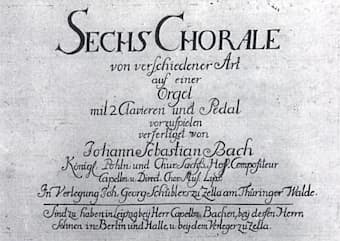
First edition of Schübler Chorales, 1740s
Johann Georg Schübler (c1720-c1755) was part of an artisan family residing in the Thuringia forest. His father made his name by cutting ornamental designs on gun barrels and trivets, and he employed a similar a process for music engravings. Presumable, at the beginning of the 1740s, Johann Georg studied privately with Johann Sebastian Bach in Leipzig, and subsequently became an organist and schoolteacher. However, Schübler’s name is more notably connected with the publication of a set of chorale preludes composed by Bach. Commonly known as the “Schübler Chorales” BWV 645-650, the engraver issued the compilation between 1747 and 1748. At least five preludes are transcriptions from movements in Bach’s church cantatas, and the composer might have hoped to provide an approachable version of the music through the marketable medium of keyboard transcriptions. Since virtually all Bach cantatas were unpublished in his lifetime, Bach was possibly looking to make a significant public statement. It almost seems that Bach himself issued his “Greatest Hits.” Since Bach had gone to the trouble and expense of securing the services of a master engraver to produce this collection, it seems to indicate that he did regard the “Schübler Chorales” as a significant publication. The chorale “Meine Seele erhebt den Herren” (My soul magnifies the Lord) was first used by Bach in his Cantata BWV 10.
Johann Sebastian Bach: Cantata BWV 61 “Now come, Savior of the heathens”

Ferrucio Busoni
A number of virtuoso pianists throughout the 19th century transcribed Bach’s music for the piano. Franz Liszt famously wrote, “The justification for transcribing Bach’s works for the piano is quite different from the reverse, and it is similar to what engraving is to the visual arts. It multiplies and spreads it.” Bach himself was a busy transcriber, and for Ferrucio Busoni “the means by which Bach’s music is communicate to the listener are immaterial, as he learnt to recognize that good, great universal music remains itself, by whatever means it is produced… The step from a first transcription to a second one is relatively short and unimportant. But a lot of fuss is usually only made about the second one. When this happens, what is overlooked is that a transcription does not destroy the original version—the one does not take the place of the other.” In his transcriptions, Busoni often resorts to bravura pianistic devices such as doublings and harmonic additions to the melodic lines, strong dynamic contrasts and differentiated articulation.
Busoni was working in the last decades of the 19th century when “European culture was perceived as increasingly decadent and degenerate.” However, there is nothing nostalgic or sentimental about Busoni’s transcription of Cantata BWV 61, “Nun komm, der Heiden Heiland (Now come, Savior of the heathens), which was first performed on 2 December 1714.

Bach: Trio super, BWV 655 “Herr Jesu Christ, dich zu uns wend”
Johann Sebastian Bach: Trio super, BWV 655 “Herr Jesu Christ, dich zu uns wend” (Lord Jesus Christ, turn to us) (Michael Form, recorder; Marie Rouquié, violin; Étienne Floutier, viol; Dirk Borner, harpsichord)
Chorale preludes are generally short settings for organ “of a single chorale strophe intended to introduce the hymn tune to be sung by the congregation.” For his Orgelbüchlein (Little Organ Book), BWV 599-644, composed between 1708 and 1717, Bach fashioned 46 chorale preludes. The chorale melody is often highly decorated with expressive ornaments, “and is usually presented over a mildly polyphonic accompaniment without any interludes separating the individual chorale phrases.” Bach had actually planned to compose 164 such chorale preludes for every occasion throughout the Church year; however, the project remained unfinished. These relatively simply chorale preludes are complemented by the Great Eighteen Chorale Preludes, BWV 651-668, which Bach prepared during his final decade in Leipzig. They represent “an encyclopedic collection of large-scale chorale preludes in a variety of styles harking back to the previous century,” and according to many commentators “the summit of Bach’s sacred music for solo organ.” The styles and forms of these so-called “Leipziger Chorales” are as diverse as that of the WTC. Bach’s most original innovation is the chorale trio in the form of a trio sonata. The upper parts are played on the two keyboards of the organ and the basso continuo is played on the pedals. The chorale “Herr Jesu Christ, dich zu uns wend” (Lord Jesus Christ, turn to us) unfolds as a jubilant and lively concerto reminiscent of Vivaldi, especially once the music is transferred to an instrumental ensemble.
Johann Sebastian Bach: Chorale Partita “Sei gegrüsset, Jesu gütig” (Hail to you, kind Jesus), BWV 768
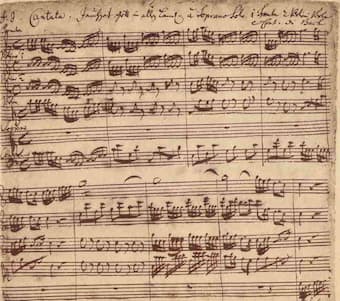
Bach: Jauchzet Gott in allen Landen, BWV 51
Music lovers around the world just adore Bach’s “Goldberg Variations,” that incredible and legendary aria and set of 30 variations. But not that many people know that Bach wrote a similar set of variations for organ. His Chorale Partita “Sei gegrüsset, Jesu gütig” (Hail to you, kind Jesus) BWV 768 uses the chorale as the starting point for a series of extraordinary variations. Essentially, the chorale partita applies the techniques of secular song variation to sacred music. The chorale is presented in a straightforward harmonization, and then subjected to a variety of contrapuntal techniques. The youthful Bach composed this particular setting during his tenure as organist in Weimar, and “he amply explores the harmonic, rhythmic and stylistic possibilities of the melody.” Bach did base his setting on some earlier models by Böhm and Pachelbel, but BWV 768 “is the culmination of all that has come before, together with, as the sequence progresses, new and richer elements which clearly point to a process of composition and revision of the whole work over a considerable period.” It is a fascinating set of variations using different formal styles to embellish the chorale melody, and “rather like the famous Goldberg set, it is something of a master class in the playing or writing of contrapuntal variations.”
Johann Sebastian Bach: Jauchzet Gott in allen Landen, (Rejoice unto God in All Lands) BWV 51 “Sei Lob und Preis” (Laud, praise and honour) (Marlis Petersen, soprano; Amsterdam Baroque Choir; Amsterdam Baroque Orchestra; Ton Koopman, cond.)
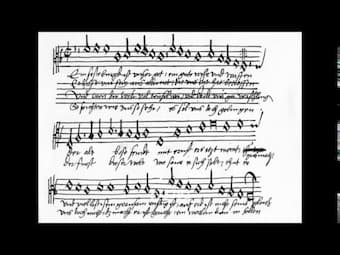
Martin Luther’s Chorale “A Mighty Fortress Is Our God”
Johann Sebastian Bach composed his solo cantata “Jauchzet Gott in allen Landen” (Rejoice unto God in All Lands), BWV 51 in 1730. Although designated for performance on the 15th Sunday after Trinity, Bach suggested that this work might be suitable for other joyous occasions as well. Much of this exuberant jubilance is expressed in the cantata text, which has been attributed to Bach himself. This piece, contrary to most cantata compositions Bach fashioned during his seven-year tenure at the St Thomas church in Leipzig, forgoes the participation of a choir. Rather, it is scored for solo soprano, trumpet, violins, violas and basso continuo. The vocal part abounds with unbridled virtuosity, giving credence to the notion that Bach designed the score for an adult female singer, rather than the customary boy soprano. Just listen to the tenderly crafted and playful violin duet, with the soprano singing the chorale tune “Laud, praise and honour” as a cantus firmus in long notes. This elaborate instrumental accompaniment leads without break into the concluding “Alleluja,” in which the soprano is once more joined by the solo trumpet in a festive and highly contrapuntal celebration.
Johann Sebastian Bach: Ein feste Burg is unser Gott, BWV 80 “Chorus” (J.S. Bach Foundation Choir; J.S. Bach Foundation Orchestra; Rudolf Lutz, cond.)
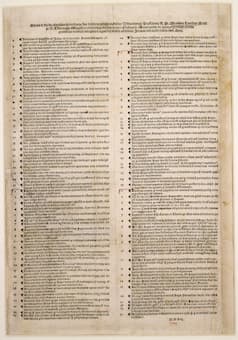
Martin Luther’s “Ninety-five Theses”
For a chorale setting featuring contrapuntal devices of awe-inspiring complexity we need look no further than the chorale fantasia that opens the Cantata “Ein feste Burg ist unser Gott (A Mighty Fortress Is Our God), BWV 80. Bach composed this chorale cantata for Reformation Day. This most important Protestant Christian holiday is celebrated on 31 October and commemorates Martin Luther nailing his “Ninety-five Theses” on the door of the All Saints Church in Wittenberg. This document details Luther’s positions against some of the abuses by the Roman Catholic Church, and retrospectively it is “considered to signal the birth of Protestantism.” It’s is not surprising that Bach pulls out all the stops, and that he uses the best known Luther hymn “A Mighty Fortress is Our God” as the basis of his compositions. The hymn dates from between 1527 and 1529, and it has been called the “Battle Hymn of the Reformation.”
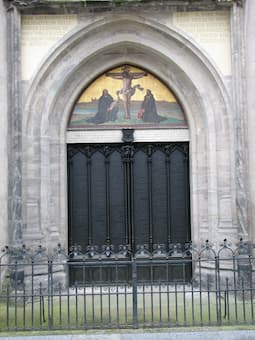
Schlosskirche in Wittenberg
Bach’s opening chorus uses a motet technique, in which the instrumental and vocal lines follow each other closely. “All four voices discuss each phrase of the chorale as a prelude to its instrumental entry using fugal devices.” The entire chorale is exclusively played in the basso continuo and the oboe lines, in canon. According to scholars, “this is one of Bach’s most elaborate choral compositions and one of the most impressive high points in the history of the chorale cantata.” With the Covid-19 pandemic still raging around the planet, I want to conclude this little survey of Bach’s chorale settings with a soothing and comforting arrangement of “God’s time is the very best time.” I am confident that it can provide solace and hope during these trying and horrible times.
For more of the best in classical music, sign up to our E-Newsletter
Johann Sebastian Bach: Actus tragicus BWV 106, “Gottes Zeit ist die allerbeste Zeit (God’s time is the very best time)

